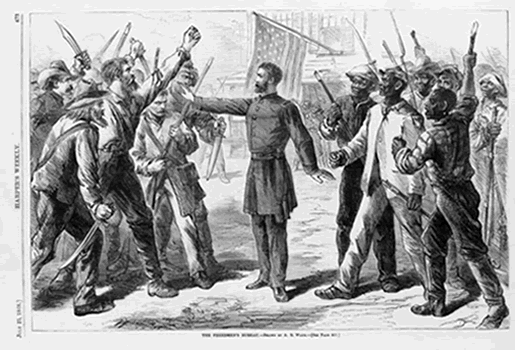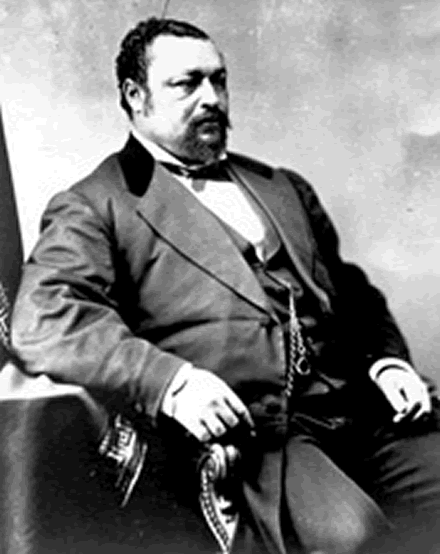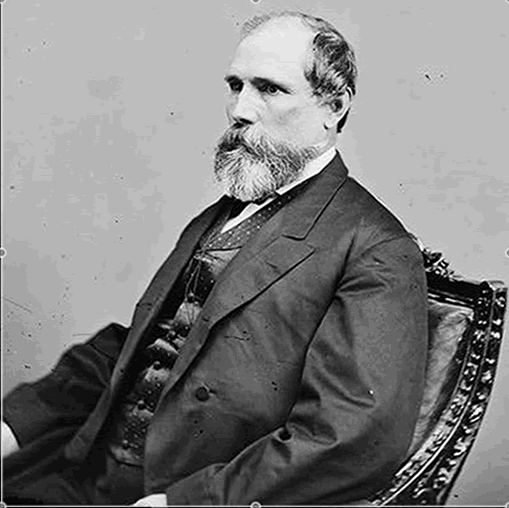“Over a century ago, prodded by the demands of four million men and women just emerging from slavery, Americans made their first attempt to live up to the noble professions of their political creed - something few societies have ever done. The effort produced a sweeping redefinition of the nation's public life and a violent reaction that ultimately destroyed much, but by no means all, of what had been accomplished. From the enforcement of the rights of citizens to the stubborn problems of economic and racial justice, the issues central to Reconstruction are as old as the American republic, and as contemporary as the inequalities that still afflict our society.” (Eric Foner, Reconstruction: America's Unfinished Revolution, 1836-1877 (1988).
Reconstruction is basically the first decade or so after the Civil War when Mississippi and the nation struggled with economic, social, and political challenges that arose from the military defeat of the South and the end of slavery. In many ways, Reconstruction is an unfinished revolution and an underappreciated period in history. W. E. B. Du Bois, the African American scholar who wrote Black Reconstruction in America (published in 1935) in order to challenge the racist interpretations of the period that dominated in the early 20th century, encouraged America to explore an honest history of the time. Du Bois wrote, "Nations reel and stagger on their way; they make hideous mistakes; they commit frightful wrongs; they do great and beautiful things. And shall we not best guide humanity by telling the truth about all this, so far as the truth is ascertainable?”
Reconstruction for Mississippi’s Black and White citizens was particularly intense. Places with the shortest, perhaps most mild, Reconstruction experience were the Upper South states of Tennessee, North Carolina, and Virginia, where formerly enslaved people were a minority of the population, and White citizens had refused to join the Confederacy until after the war’s first military engagement at Fort Sumter. States with the longest and most divisive Reconstruction were states where most of the population was Black and whose White leaders had established the Confederacy, such as South Carolina, the first state to secede from the Union, and Mississippi, the second to secede. Reconstruction, which went through two phases, lasted for eleven years in Mississippi.
Being the center of slavery and cotton culture, heavily agricultural places such as Mississippi seceded first and returned to the Union last. Planters, who had produced cotton for the world market, emerged from the Civil War in a state of shock. They had enslaved their workforce for generations. After emancipation and Confederate defeat, many White Mississippians still thought they had been right to own enslaved people and secede from the Union. This position, within a state where the population was 55 percent Black, foreshadowed a difficult Reconstruction.
Black and White Mississippians grappled with a devastated economy and a new social structure. To assist them and other southerners, the United States Congress in March 1865 established the Freedmen’s Bureau as part of the War Department. The Bureau had many important responsibilities. It distributed clothing, food, and fuel to freedmen and White refugees. It helped to establish many of Mississippi’s first public schools. It protected the civil rights of formerly enslaved people by offering them legal counsel. Faced with limited resources and resistance from many White southerners, the Bureau failed to accomplish many of its goals. According to historian Eric Foner, “Bureau schools nonetheless helped lay the foundation for Southern public education.”
Presidential Reconstruction, 1865-1867
In May 1865, a month after the end of the American Civil War and the assassination of President Abraham Lincoln, new U.S. President Andrew Johnson issued guidelines for re-admittance of the former Confederate states into the Union based on the Reconstruction plans that Lincoln had developed during the war. The president offered amnesty to individuals who would take an oath of loyalty to the United States, but there were exceptions. Confederates who had held high civil or military offices during the war and those who had owned property worth $20,000 or more in 1860 had to apply individually for a presidential pardon. When 10 percent of the voters in a state had taken the oath of loyalty, the state would be permitted to form a legal government and rejoin the Union. In Mississippi, Johnson appointed William L. Sharkey, a Union Whig, as provisional governor to guide Reconstruction in the state and to organize an election of delegates for a state constitutional convention.
Colonel Samuel Thomas, the assistant commissioner of the Freedmen’s Bureau who opened the Bureau office in Vicksburg, noticed White Mississippians’ defiant posture when he traveled through the state months after the war.
“Wherever I go—the street, the shop, the house, or the steamboat—I hear the people talk in such a way as to indicate that they are yet unable to conceive of the Negro as possessing any rights at all.” Thomas worried that White people “who are honorable in their dealings with their white neighbors will cheat a Negro without feeling a single twinge of their honor. To kill a Negro they do not deem murder.” Such men openly boasted to Thomas that Black people “will catch hell” when local White people re-acquired political control. Trying to explain this defiance, Thomas pointed to prejudices seared into White minds and hearts during the era of slavery. As Thomas put it, though White Mississippians “admit that the individual relations of masters and slaves have been destroyed by the war and the President's emancipation proclamation, they still have an ingrained feeling that the blacks at large belong to the whites at large.”
In 1865 this deep prejudice appeared in Mississippi’s notorious Black Codes enacted in late November by the newly elected Mississippi Legislature. One of the first necessities of Reconstruction was to define the legal status of formerly enslaved people. How would Mississippi define citizenship? Which civil rights would the state legislators give to freedmen? Instead of embracing change Mississippi passed the first and most extreme Black Codes, laws meant to replicate slavery as much as possible. The codes used “vagrancy” laws to control the traffic of Black people and punished them for any breach of Old South etiquette. Black people could not be idle, disorderly, or use “insulting” gestures. Black people could not own a gun or preach the Gospel without first receiving a special license. Black children were forced to work as “apprentices” for White planters, usually their former masters, until they turned eighteen. Most blatant of all, the state penal codes simply replaced the word “slave” with “freedman;” all the crimes and penalties for enslaved people were “in full force” for the emancipated.
On one level, the Black Codes made a political statement. White Mississippians meant to limit the political power of Black people by denying them civil rights. On another, deeper level, these codes revealed an economic struggle between former masters and freed enslaved people. Ex-masters wanted to force Black people to work as they had during bondage. Freedmen desired something else. They sought land to rent or own; they wanted self-sufficiency and independence from the old ways of plantation agriculture. Though most Black people wanted physical and economic distance from their terrible past, few achieved this goal. Black people who saved money to purchase land seldom found a White man who would sell it to them. In parts of Mississippi when Black people offered to purchase land at $10 an acre, landowners refused and then sold the property to White people for half that price.
This White defiance had unintended consequences. Declining land prices and a failing cotton market threatened the livelihood of White planters. Proud men who had withstood wartime destruction and postwar uncertainties faced spiraling debt. Over 150 planters near Natchez, one of the wealthiest cotton regions in the world, forfeited their land to pay debts or back taxes. Something had to give. In time, when neither White nor Black people could achieve their economic aims, landowners and laborers compromised by creating the sharecropping system. Planters provided land, animals, seed, and fertilizer; freedmen provided labor. They split the crop. This was hardly an ideal arrangement, but it resolved an economic impasse between land and labor, White and Black. Former masters were guaranteed a constant source of labor, and formerly enslaved people could work a separate plot of earth, though they did not own it.
Radical Reconstruction, 1867-1876
Testimony from officials like Thomas and the oppressive Black Codes convinced Congress that Mississippi and other states needed a more thorough Reconstruction. Congressional, or Radical, Reconstruction ensued. In Mississippi this period contained great achievements and embarrassing failures. One of the greatest successes was Black participation in democracy, both as voters and office holders. At least 226 Black Mississippians held public office during Reconstruction, compared to only 46 Black people in Arkansas and 20 in Tennessee. Mississippi sent the first two (and only) Black senators of this period to Congress. The first senator, Hiram R. Revels (1827-1901), was a free Black person from North Carolina who served as a chaplain to Black troops during the Civil War. Revels moved to Natchez in 1866 and founded schools for freedmen throughout the South. The second African-American senator was Blanche K. Bruce (1841-1898). Bruce’s parents were a Virginia enslaved woman and her master. In Bolivar County, Mississippi, Bruce encouraged Black political participation as the county sheriff, tax collector, and superintendent of education. This local political base catapulted Bruce to a U.S. Senate seat in 1875.
Other Black and White Mississippians promoted a biracial political society. Former slave owner James Lusk Alcorn showed that not all White planters opposed progress. Alcorn created a political constituency that included northern Republicans who moved to the state, derisively called “carpetbaggers,” other White Mississippians who favored change, derisively called “scalawags,” and Black Republicans, like James D. Lynch, Mississippi’s secretary of state.
But Radical Reconstruction infuriated southerners committed to white supremacy. As Republicans implemented political equality, terrorist groups used intimidation and violence to halt progress. The foremost of these organizations was the Ku Klux Klan. Established in Tennessee in 1866, the Klan became a violent paramilitary organization that often promoted planters’ interests and the Democratic Party. Klansmen hid beneath costumes meant to represent the ghosts of Confederate soldiers, but they often unmasked themselves when committing violence. This act sent a chilling message to their victims: Klansmen thought they could murder with impunity, because local authorities were unwilling or unable to stop them. The Klan targeted Republicans, “outspoken” Black people, and workers who challenged planter rule. In Monroe County, Klansmen killed Black Mississippian Jack Dupree in front of his wife. The Klan targeted Dupree because he led a local Republican Party group and spoke his mind. Throughout Mississippi the Klan also sought to uphold planter authority by disciplining troublesome workers. Klansmen whipped a Black woman for “laziness,” and pummeled a freedman for legally suing a White man. The terrorists told him that “darkeys were through with suing white men.” Mississippi courts, Black churches, and schools became frequent targets of racial violence. In Meridian three Black leaders were arrested in 1871 for making “incendiary” speeches. During the Black men’s trial, Klansmen shot up the courtroom, killing the Republican judge and two defendants. The violence sparked a bloodbath in Meridian; White rioters picked out dozens of Black leaders and murdered them in cold blood.
In time these violent tactics ruined democracy in Mississippi and throughout the South. In Vicksburg, White supremacists formed the White Man’s party, patrolled the streets with guns, and convinced Black voters to stay home on election day. Their insurgency worked; Democratic candidates committed to White supremacy replaced every Republican incumbent in the 1875 elections. After this success, insurgents used violence and voter fraud to gain political control of the state. When the federal government refused to address these crimes, John R. Lynch, Mississippi’s Republican congressman, warned that “the war was fought in vain.” If all men were not equal before the law, America had not advanced very far since the Civil War. One hundred years later, the civil rights movement achieved the freedom that Lynch and thousands of other Mississippians first won and then lost during Reconstruction. For Lynch and his fellow Mississippians, these tumultuous postwar years were the best of times and the worst of times.
Jason Phillips, Ph.D., is assistant professor of history at Mississippi State University. This article was updated in September 2021.
-

William L. Sharkey (1797-1873) Twenty-fifth Governor, 1865 Courtesy, Mississippi Department of Archives and History. -

An illustration in the July 25, 1868, Harper’s Weekly shows a man representing the Freedmen’s Bureau standing between armed groups of whites and blacks. Image courtesy Library of Congress Prints and Photographs Division, Washington, D. C. LC-USZ62-105555.
-

Hiram R. Revels of Natchez was appointed by the predominantly Republican Mississippi Legislature in 1870 to serve out the unexpired term of Jefferson Davis and became the first black to serve in the U. S. Senate. Photo courtesy Library of Congress Prints and Photographs Division, Washington, D. C. LC-BH83-1823. -

Republican Blanche K. Bruce of Bolivar County, Mississippi, in 1875 was the second black sent to the U. S. Senate and was the first black to serve a full term in the Senate. Photo courtesy Library of Congress Prints and Photographs Division, Washington, D. C. LC-BH832-30088. -

Circa 1883 chromolithograph titled “Heroes of the colored race,” has portraits of Blanche K. Bruce, Frederick Douglass, and Hiram R. Revels surrounded by scenes of African-American life. Image courtesy Library of Congress Prints and Photographs Division, Washington, D. C. LC-USZC2-1720. -

Former slave owner James Lusk Alcorn created a political constituency that showed not all white planters opposed progress. Photo courtesy Library of Congress Prints and Photographs Division, Washington, D. C. LC-BH826-1657.
References:
Busbee, Jr., Westley F. Mississippi: A History. Wheeling, Illinois: Harlan Davidson, 2005, pp. 148-163.
Foner, Eric. Reconstruction: America’s Unfinished Revolution 1863-1877. New York: Harper & Row Publishers, 1988.
Kolchin, Peter. A Sphinx on the American Land: The Nineteenth-Century South in Comparative Perspective. Baton Rouge: Louisiana State University Press, 2003.
Samuel Thomas, Testimony Before Congress, 1865, placed online by Stephen Mintz at the University of Houston at http://chnm.gmu.edu/courses/122/recon/thomas.htm (accessed April 2006)
